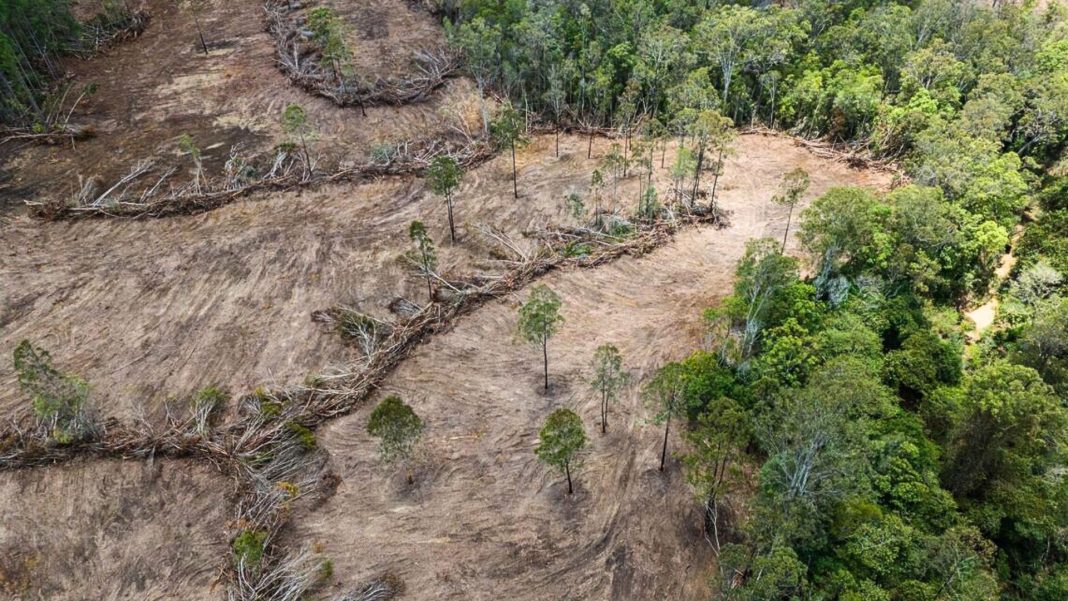Australia is undergoing a sustained, mostly hidden deforestation crisis of a globally concerning scale. And recent research reveals that this destruction of our forests and bushlands may not be compliant under national law.
Un-referred deforestation: what is it?
Australia holds over 10% of the world’s biodiversity, and our unique animals, plants and ecosystems reflect millions of years of continental isolation and evolution.
Despite being home to globally unique flora and fauna, we tragically have one of the highest rates of deforestation in the world. Worse still, we’re a global loser in mammal extinctions: over 30 native Australian mammals are gone forever.
Satellite imagery below shows deforestation near Lawgi Dawes, Queensland.
Over 270 hectares of forest was destroyed – this may have included habitat for endangered Greater Gliders, Koalas, and the critically endangered Coxen’s Fig-Parrot.
Australia has national environment laws in place designed to protect our forests, bushlands, and native species from deforestation, but for decades these laws have been seriously failing.
What are these laws, and how are they meant to work?
The Environmental Protection and Biodiversity Conservation (EPBC) Act, which was introduced in 1999, requires any person who wants to undertake a project to decide if their actions will significantly impact a protected matter (threatened animals, plants or special places like the Great Barrier Reef).
If it is likely to significantly impact a protected matter, the proponent must “refer” the activity (for example, deforestation of koala habitat) to the Federal Government for approval. The Environment Minister will then decide whether or not the project should go ahead based on the potential impact it might have on wildlife and ecological communities.
Un-referred deforestation is deforestation activity that takes place without appropriate federal government approval. It has completely by-passed the requirements of the EPBC Act.
A shocking study from University of Queensland in 2019 revealed that 93% of threatened species habitat that was cleared after the Act was introduced, was done so without being referred to the Federal government for approval.
Un-referred deforestation may be against the law – but it continues unabated because politicians are turning a blind eye.
Our broken environment laws
The forests team at Greenpeace recently interviewed Hannah Thomas, a PhD candidate at University of Queensland who is currently studying deforestation in Australia and its impacts on Australian biodiversity.
We spoke about the EPBC Act, and why it’s failing our wildlife and forests. Listen below.
Less than 25% of the deforestation that involved the loss of more than 20 hectares of threatened species habitat in northern Australia had evidence of federal government approval.
Hannah’s research revealed that 78% of all deforestation that occurred in northern Australia was relevant to the EPBC Act and involved the loss of threatened species habitat or threatened ecological communities.*
This proves that our nature laws are weak, not enforced, and they’re failing the dozens of vulnerable, endangered and critically endangered species and ecosystems that are being destroyed by deforestation.
*Only clearing events ≥20 hectares were included in the analysis. Many deforestation events were excluded below this conservative threshold.
The Greater Glider and the Great Barrier Reef
Greenpeace Australia Pacific, the Wilderness Society and Queensland Conservation Council have recently referred 13 instances of potential illegal deforestation to the Environment Minister Tanya Plibersek.
Most of these deforestation events occurred in Queensland, and impacted critical habitat for many iconic Australian wildlife, including the Greater Glider.
The Greater Glider is a tree-hollow-dwelling mammal which glides from tree to tree – it can glide up to 100 metres in search of a new spot to nest.
Greater Glider populations have declined by 80% in just 20 years. In 2022, the Greater Glider was uplisted from vulnerable to endangered on the federal government’s list of threatened species. This rapid decline, caused by habitat loss, has been mostly attributed to deforestation and bushfires. Without tree hollows, Greater Gliders won’t survive.
Iconic ecosystems such as the Great Barrier Reef are also suffering the impacts of Australia’s extensive deforestation.
When forests within the Great Barrier Reef basin are destroyed, soil and poisonous chemicals from agricultural run-off end up in the fragile waters of the Reef.
Australian deforestation also contributes considerably to Australia’s greenhouse gas emissions, adding further fuel to the fire of climate change – which is the single biggest threat to the Reef.
Australia desperately needs stronger national environment laws that are properly enforced in order to safeguard ecosystems such as the Great Barrier Reef, and to give threatened species such as the Greater Glider a better chance of survival.
Send an email to your MP now to call for strong nature law reform this term.
Click here to read more of Hannah Thomas’ research on non-compliant deforestation in Australia.


